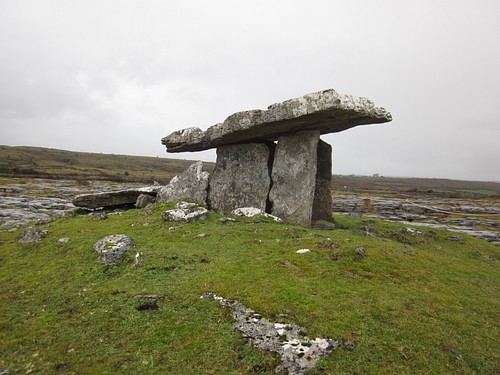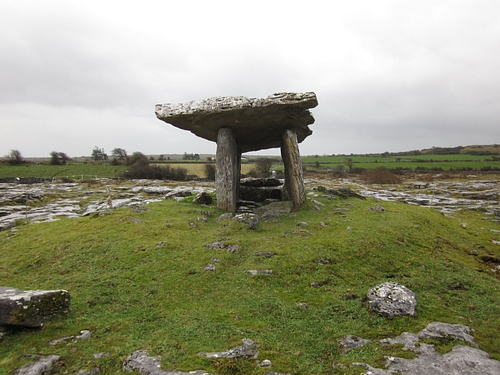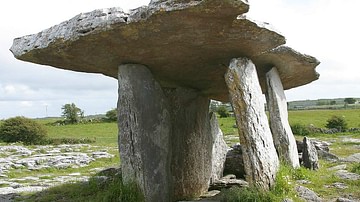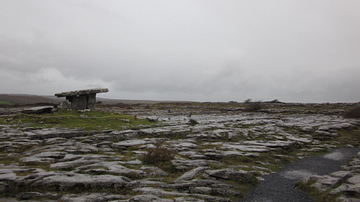
Poulnabrone is a portal tomb in the region known as the Burren, County Clare, Ireland and the oldest dated megalithic monument in the land. The name means "Hole of the Quern Stones", but the site is also commonly referred to as "Hole of the Sorrows". Dated to c. 4200 BCE it stands 5.9 feet high (1.8 meters) and 12 feet (3.6 meters) long in a field surrounded by the karst stone formations which make up the Burren. It is defined as a dolmen: a single-chamber, megalithic tomb distinguished by a capstone resting on upright stones.
It is the best known and most often photographed of the almost 200 dolmens in Ireland because of its near perfect symmetry. Excavations at the site in the 1980's CE uncovered human remains and grave goods, establishing the site as an ancient tomb, but it may have served other purposes as well. Dr. Carleton Jones, who worked at the site, suggests it may have been an "ancient billboard" as well as a tomb marking the territory of the tribe of the Burren.
Construction of the Megalith
The stones used in construction were raised from the local area, although theories have persisted that they were brought from further afield, and were then assembled with perfect balance and precision using no concrete and no compounds whatsoever. The massive capstone of Poulnabrone rests on five upright stones: two portal stones, two orthostats (upright stones), and an end stone. Archaeologists who have worked at the site since the first excavations in 1986 have concluded that Poulnabrone was erected as a doorway between this world and the next based upon artifacts uncovered there and the slant of the capstone.
The burial chamber measures 9 inches (25 cm) deep, though archaeologists believe it was once deeper — 21.6 inches (55 cm). In 1985 CE the capstone cracked and the dolmen collapsed; this provided archaeologists with the opportunity to excavate the site thoroughly without worrying about disturbing the dolmen's delicate position. When the work was concluded, the capstone was repaired and Poulnabrone reassembled precisely as it had been before.
Excavations
Excavations by archaeologist Ann Lynch in 1986 and 1988 CE found the remains of 22 people from the Neolithic Age buried in the dolmen: 16 adults, six children, and one newborn. All the adults had died before the age of 40. The skeletons were brought to the tomb after the bodies had decomposed elsewhere, suggesting to Lynch an elaborate burial ritual in which the flesh and organs of the deceased had to first be returned to the earth before the more enduring bones could be placed in the portal to the next world.
Some of the skeletons showed scorch marks, indicating they had been burned, but Lynch ruled out the practice of cremation since the marks were so uneven and the bones largely intact. She suggests that parts of the bodies were burned away to hasten interment in the dolmen, possibly because of an imminent festival or ritual. As these festivals corresponded to astronomical/seasonal occurrences, they could not be delayed in waiting for a body to decompose at its leisure.
Along with the skeletons, Lynch found a polished stone axe, beads, jewelry, arrowheads, pottery sherds, and other remains of personal possessions, all indicating a tomb for people of high standing in the community, most likely a chieftain and his family. The capstone of the monument is at an angle, and the skeletons of the deceased were placed in the front, at the highest point of the roof, with their possessions.
It is thought that the dolmen was designed this way to enable the soul to depart easily from the lower angle at the back. Although scholars and archaeologists can only speculate, it is possible that the low angle had to do with the ancient inhabitant's vision of the Underworld and the monument was specifically tilted in recognition of the Otherworld above the earth and the Underworld below; the slope of the back angle was thought to hasten the departure of the soul down to the realm of the afterlife.
Poulnabrone as Portal
This Underworld, it should be noted would have had no correlation to the later concept of a "hell" where souls are punished; it was simply another realm of the Otherworld. These concepts are only known to have arisen later in Celtic culture, as there is no way of knowing what the people who built Poulnabrone believed since they had no written script, but it seems likely, based on excavations and the positioning of the capstone, that those who constructed it believed something along the lines of their descendants.
Celtic deities were closely tied to the land, and this was especially so of the Morrigan, the phantom queen associated with war, death, and regeneration/rebirth. The Morrigan was at once beautiful and terrifying, taking souls from the battlefield and carrying them away like the Norse Valkyrie or appearing at the moment of death by the hearth or in the field to wrench the soul from the body. The Morrigan and other deities, spirits, faieries, and sprites were greatly feared, and defences were built against them at sacred sites throughout Ireland.
The Giant's Ring, a sacred site in Ballynaratty, near Belfast, is a henge monument dating from c. 2700 BCE and consisting of a wide basin surrounded by an earthwork. This same sort of construction can be seen elsewhere at similar sites in Ireland, such as the Hill of Tara in County Meath. Historian Jonathan Bardon comments on this, writing, "It is clear that they were not constructed for military purposes as the ditch in each of the locations was placed inside rather than outside the great circular earthen enclosures. If defence was needed, it was against hostile spirits from the Otherworld" (14).
In this same way, it is possible that Poulnabrone was constructed not to ease the passage of the soul to the next life but to discourage spirits of the other realm from entering the world of the living. Every dolmen in Ireland is constructed in this same way, with the slanting capstone, many much larger than Poulnabrone's. The capstone of the Kilclooney dolmen in County Donegal measures 13 feet long and and 20 feet across.
Perhaps the monument was designed with the downward sloping back angle as a kind of one-way sign for unseen spirits. As with every aspect of Poulnabrone, however — and the other dolmens — this is purely speculation. Dr. Jones suggests that the angle may serve the same purpose as the design of modern houses of worship. He writes:
Early antiquarians sometimes dismissed megalithic tombs as “rude stone monuments,” lacking in aesthetic value. Today, with a more open mind, it is not hard to see [Poulnabrone's] aesthetic qualities. The monument is an amazing balance of mass and energy. The mass is provided by the bulky stones rising straight up from the ground while the energy is captured in the almost precarious tilt of a massive capstone, balanced high above and pointing skywards. Perhaps, Poulnabrone embodies that long gone society's striving for spiritual answers, in much the same way a Gothic arch or a steeple on a modern church reaches towards heaven (1).
Conclusion
The monument was never "discovered" in any dramatic fashion. It has always been standing, except for its brief collapse in the 1980's CE, right where it stands in the present day. Although the interpretation of the name as "Hole of Sorrows" has been discredited by scholars on the subject, the people who live near the site know it by that name as well as "Place of Sorrows". The arrangement of the bodies in the tomb as found by Lynch, and the artifacts buried with them, suggests they were important people to the community, and perhaps the loss of these individuals continued to resonate in the grief of the community long after their passing, giving the site its local association with sorrow.
This theory is far from improbable. The Irish have a long memory and evidence of that is plentiful. Only one example of this is the megalithic monument Newgrange in County Meath, which takes its modern name from references by local people in the 1960's CE to the area as the new grange (farm) of the monks of Mellifont Abbey, which was closed in 1539 CE during the Protestant Reformation.
Poulnabrone is a very popular tourist attraction in the present day, with bus tours stopping there regularly in season. In Dr. Jones' words, "it was built to impress, and it still does over 5,000 years later." The monument sits silently in it karst field beyond the parking lot as visitors come and go, as they have through the centuries, while the quiet dolmen remains, keeping its ancient secrets.




